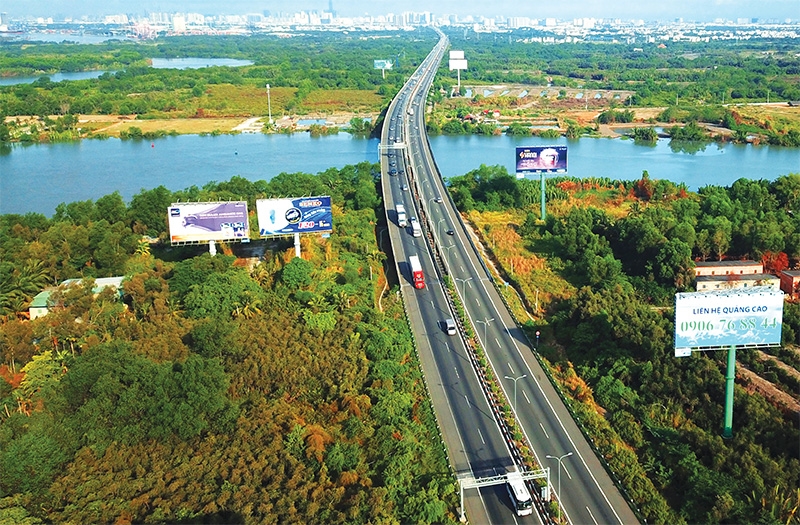New expressways lift up interconnectivity
 |
| New expressways lift up interconnectivity. Photo: Le Toan |
On the site of the Trung Luong-My Thuan Expressway project, more than 100 engineers and other staff are attempting to speed up construction, with a bustling atmosphere taking place over machines and equipment in full operation.
Trinh Van Tai, an expert on the expressway’s management board, said that contractors are focusing all of their efforts on completing the final stages so as to scatter asphalt of the surface of the XL04 section in early December.
The XL04 section, connecting Cai Be district of the Mekong Delta province of Tien Giang, is one of several packages of the project, with the majority of the construction of the foundation already completed, in addition to key works of bridges.
Nguyen Tan Dong, general director of Trung Luong-My Thuan BOT JSC, said that after over one year of development, about two-thirds of the project has been finished. “We plan to open for some traffic by the end of 2020,” Dong said.
The 54km long expressway is part of the Ministry of Transport’s (MoT) plan to develop an expressway network of 300km in the Mekong Delta region by 2025 to satisfy growing travelling demands among both locals and businesses.
The MoT is also developing a number of other ventures. At present, the 40km Ho Chi Minh City-Trung Luong Expressway is already operational, while My Thuan Bridge II and a connecting road of 7km will be completed in 2023.
At the National Assembly’s November interpellation, Minister of Transport Nguyen Van The said, “The 300km expressway target for 2025 is feasible because many important projects are scheduled to be completed by then.”
In addition, construction of 23km running from My Thuan Bridge II to the Mekong Delta city of Can Tho will be kicked off in December, and together with the route from Cai Gon to Can Tho Bridge, about 130km of expressway connecting Ho Chi Minh City to Can Tho will be put into use by 2023.
Next month, Prime Minister Nguyen Xuan Phuc is scheduled to attend the inauguration of the 51km Vam Cong-Rach Soi Expressway.
“Elsewhere, we plan to open an expressway connecting Lang Son to Ca Mau city by 2025. This means that around 170km of route from Can Tho to Ca Mau will be a priority in the 2021-2025 term,” minister The noted.
If everything goes smoothly as expected, by 2025 the country could even reach up to 400km of expressway in the region.
Transport experts have expressed their high hopes for the MoT plan because the network from Ho Chi Minh City to the Mekong Delta remains underdeveloped, leading to serious traffic jams and causing negative impacts on business activities amid strong socioeconomic development in the region.
Senior transport expert Le Do Muoi told VIR, “With this strong determination from the government, the plan is feasible. Moreover, because a better transport network in the region is an urgent need, leaders in regional cities and provinces are making strong moves in order to hand over cleared land for construction.”
The Mekong Delta has become an appealing destination to domestic and international investors in recent times with the US, Japan, and South Korea among countries creating strong interest in agriculture, processing and manufacturing, and clean energy.
According to regional statistics, in the first eight months of 2020 the region attracted a total of nearly $5 billion worth of new and added foreign investment, as well as state acquisitions. Dong Thap, Long An, Ben Tre, Vinh Long, and Can Tho provinces are deemed the most attractive spots.
Vo Tan Thanh, vice chairman of the Vietnam Chamber of Commerce and Industry, said that the region has been near the top of the country’s Provincial Competitiveness Index among regions over the last half-decade, with five regional localities named in the country’s top 20 in the index.
What the stars mean:
★ Poor ★ ★ Promising ★★★ Good ★★★★ Very good ★★★★★ Exceptional
Related Contents
Latest News
More News
- Vietnam's IFC to target global investment flows (December 21, 2025 | 18:00)
- Two national hospitals expand capacity with new facilities (December 20, 2025 | 09:00)
- Ha Tinh breaks ground on major Vingroup industrial and energy projects (December 19, 2025 | 18:24)
- EVN launches major power infrastructure projects nationwide (December 19, 2025 | 18:17)
- VAL inaugurates second production line to meet domestic animal feed demand (December 19, 2025 | 16:37)
- Sun Group pioneers urban tram system in Phu Quoc (December 19, 2025 | 15:00)
- Seven major projects launched to drive Hanoi’s next growth phase (December 19, 2025 | 14:00)
- Securing capital and efficiency for Vietnam’s 2026-2030 growth ambitions (December 17, 2025 | 10:00)
- Vietnam bucking trend in the global M&A landscape (December 16, 2025 | 14:20)
- HDS Summit spotlights Vietnam’s rising role in regional supply chains (December 16, 2025 | 08:00)

 Tag:
Tag:





















 Mobile Version
Mobile Version